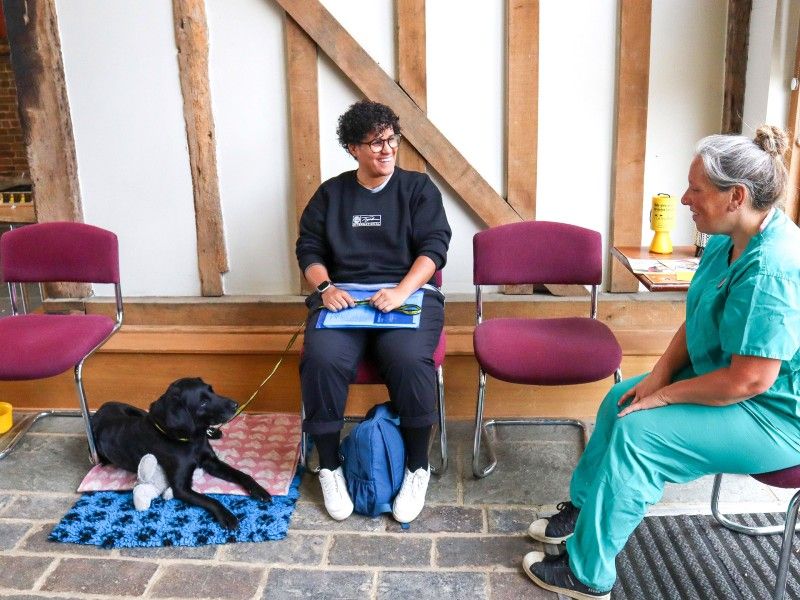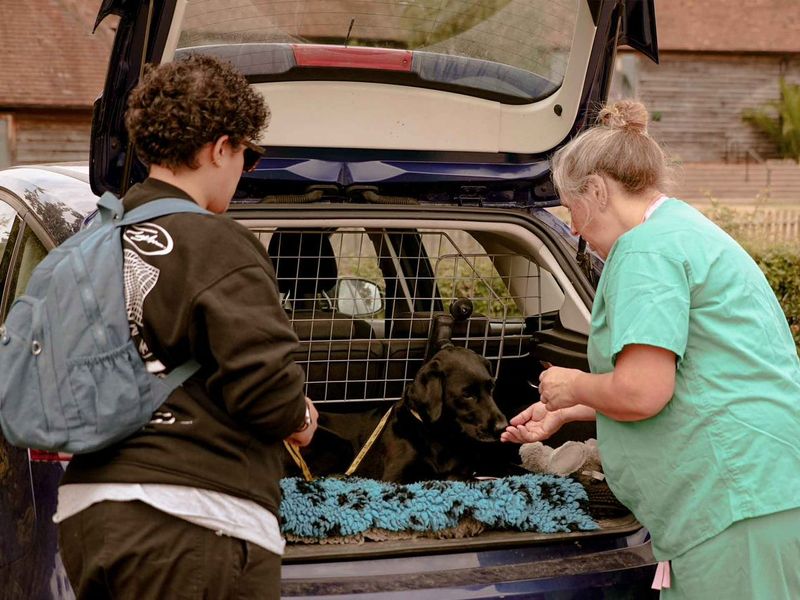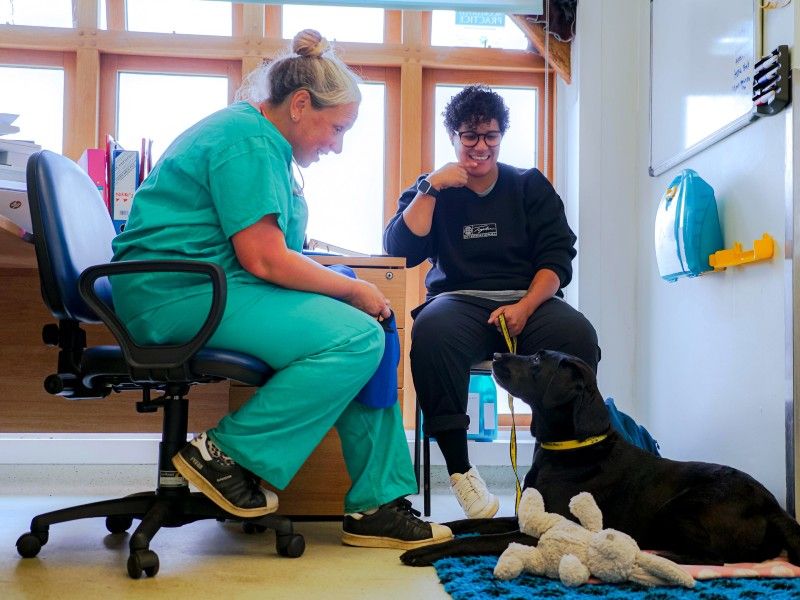Preparation of the clinic environment
Every vet care provider may implement measures aimed at optimising patient-experience. Discover more.

Veterinary treatment is provided within a wide range of premises, from purpose-designed buildings to mobile units.
Although available resources may differ between clinics, every provider of veterinary care may implement measures aimed at optimising the patient experience, particularly from the patient's perspective.
Layout, design and patient flow
Species-specific entrances and exits, waiting areas, and even consulting rooms and sessions may help to reduce feelings of vulnerability and anxiety, as well as excitement and frustration, for dogs who struggle when exposed to other species.
However, they will not address any dog-dog concerns, including fear, anxiety, excitement and/or frustration. Therefore, additional measures may need to be implemented to avoid interactions between dogs.
For dogs who find the clinical environment challenging – overloading their senses with a lot of information to process – it’s practically impossible to avoid the sound and smell of other animals.
Although screening can help to block sight, where available. However, dogs should be able to avoid coming into physical contact with any party other than their owner or a relevant member of the clinic team.
Ways to prevent species from interacting
We understand that in most veterinary clinics it is not possible to completely change the clinic layout. However, there are ways to help prevent direct interaction between patients:
- Locally determined patient-flow protocols are designed to avoid dogs having to return through busy areas of the clinic. For example, being safely shown out of the premises via a different route which avoids the waiting area
- Dispensing of any necessary medicines and booking future appointments either within the consulting area or in a separate area, through which the patient may leave, avoiding the waiting area completely
- Dividing the reception desk to apportion individual areas for clients to check in or book appointments and collect prescriptions or diet.
Waiting procedures
Ideally, clinics will have an outside space in which clients may wait with their dogs to create distance between their dog and any other animal present. Dogs who are well used to and comfortable in the car may prefer to wait there with their owner, if climatically safe to do so.
The reception team will therefore benefit from a system that allows clients to wait outside and be called when the clinician becomes available.
A similar system may already have been implemented by the clinic during the Covid restrictions and should therefore be considered for adaption or continuation.

Screening
Within waiting areas, visual screening to prevent inter-patient/owner interaction can be achieved in a variety of ways:
- Repositioning of chairs back-to-back and not immediately adjacent to provide between-patient space
- Free-standing notice boards or covered tables used as between-patient barriers
- The reception desk itself as a blocking aid.
Signage
It is important to have the appropriate signage, if applicable, within the waiting area. For example, dog waiting area, cat waiting area or exotics waiting area.
This enables the reception team to direct owners to the appropriate seating areas. The worldwide Cat Friendly Clinic programme also advocates species-specific waiting areas. Visit their website for more information.
The reception team should feel confident to ask owners to create more distance between their dog and another animal or person if they feel this helpful or necessary.
Mobility measures
Additional considerations include providing extra rubber matting for dogs with mobility issues or concerns about different types of flooring. For example, some dogs find laminate flooring especially difficult to walk on.
Some find flooring they anticipate as being slippery particularly challenging, even though it isn’t, simply because their expectation – through previous experience – is that it will be.
Similarly, raised water bowls can be a useful introduction for dogs with mobility and/or painful problems, as they avoid a dog having to place their weight forwards and bend their spine.
These also avoid taller dogs having to splay their forelegs.
Use of treats
During waiting times, the reception team should be able to provide a variety of treats for owners to use to reinforce desired behaviour displayed by their dog, such as settling down and focusing their attention on their owner.
Treats can also create a positive association with being present in the clinic. The reception team should, however, always check with the owner that treats are appropriate.
The clinic may wish to create their own policy, but common contra-indications for giving treats include:
- being admitted for a general anaesthetic
- being admitted for sedation
- requiring a blood test
- gastrointestinal disease symptoms
- pancreatitis
- being on a diet trial
- diabetes
- dental issues
- known food intolerances (the ingredients of the treats should be clearly displayed, so the owner is informed)
- neurological disease symptoms
- major trauma.
It is worth noting that dogs that are nervous in the waiting room may not take a treat from a member of the veterinary clinic team. However, they might take a treat from the owner or if the treat is place on the floor.
Other measures
The reception team should also be able to provide towels for drying wet dogs during waiting times, as long as dogs are well-used to being towel-dried and are unlikely to find this unpleasant.
Reducing noise within the clinic reception and waiting areas can be beneficial for both the patients and their owners. Simple ways to achieve this include:
- reducing the ring volume of reception phones
- encouraging dogs to settle
- clinic staff wearing soft soled shoes.
A reception team underpinned with knowledge of basic canine behaviour should be able to help owners identify signs of escalating discomfort, stress, anxiety and fear in their dogs and take steps to reduce this.
The reception team should be confident in guiding owners into helping their dogs relax. For example, by asking them to take their dog for a short walk should the dog have arrived at the clinic highly aroused, or if they appear to need to go to the toilet.
Likewise, a reception team should be best placed to reassure owners of dogs who have toileted within the clinic not to worry.
Owners ought to be reassured this is understandably normal behaviour within this environment, and the reception team is ready to clean up any mess appropriately, in accordance with standard clinic cleaning and disinfecting protocols.
Cleaning up right away can also help to reduce the presence of strong, lingering odours.
Communicating with careful consideration
However, care should be taken whenever communicating to an owner that the clinic team perceives their dog as becoming distressed or uncomfortable, as this might make an owner feel embarrassed, anxious, scrutinised, or even judged.
How the message is conveyed is just as important as the message itself, which is being delivered out of concern and care for the dog’s feelings, so this can be a focal point for communications.
Using reassuring language which guides an owner into making a good choice for their dog can help to soften any potential risk of an owner feeling confronted and exposed, especially in front of other pet owners.
For example, “Do you think your lovely girl would prefer to settle over here with a little bit more space around her. She might feel a little bit less exposed settling away from the front door?” might be experienced as more encouraging and supportive than, “Please can you move over here as your dog is getting stressed and unsettling everyone else”.
How we frame things for owners can make a difference to them feeling autonomous in terms of making good decisions on their dog’s behalf.
Choosing our words carefully to encourage owners to make sensible choices can be much more empowering, and well-received than simply telling owners how their dog is feeling and how to behave.
Consultation rooms
Information regarding how to positively introduce yourself and the consulting area and how to carry out a low stress clinical examination are discussed in the handling of dogs during consultations section.
There are, however, simple additions to the consultation room that can help to make a dog feel more comfortable:
- non-slip rubber matting on the consultation room table, scales and floor, if necessary
- additional padding available for the table during longer procedures (e.g. ECG or ultrasound)
- treat jars (with a list of ingredients within the treats)
- prompt cleaning of the consultation room table after consultation to decrease the odours from a previous animal
- positioning furniture to allow for more space. For example, turning a table around and against a wall to free up floor space
- providing chairs for the owner(s) and veterinary professional to be able to sit to discuss the dog during longer consultations. A blanket or dog bed might also help a dog and their owner(s) to relax.

Products and equipment sold
As well as life-stage and prescription diets, it is standard practice for clinics to promote a wide range of dog-focused toys and training aids within their waiting room.
With so many products available, it is important to use any sales point as an opportunity to educate and guide dog owners into purchasing items.
This should be based on positive reinforcement that their dog's experience will be pleasant and rewarding.
Rewards-based training products
Dogs Trust and the British Veterinary Behaviour Association believe that every dog should be trained using reward-based methods underpinned with robust scientific evidence.
We object to the use of any equipment or techniques that use discomfort, pain, or fear to train a dog.
For this reason, Dog Friendly Clinics should neither sell nor recommend products which might be found aversive by dogs, for example:
- any item of canine clothing or attachment designed to deliberately deliver a painful stimulus, such as an electric shock. For example, an electric shock or prong collar
- collars or leads designed to tighten around the neck, therefore temporarily or prolongedly restricting the dog’s airway. For example, check or choke chains. These might be experienced as painful, threatening and/or worrying
- collars or attachments designed to emit a strong scent, puff of air or noise, which the dog is likely to find unpleasant or frightening and potentially frustrating if they feel they cannot avoid it
- products designed to interrupt, prevent, or discourage undesirable behaviour. For example, water or air sprays or items that make an unpleasant noise
- muzzles that prevent a dog from eating, drinking, or panting (for dogs who wear muzzles in public)
- clothing specifically designed towards human entertainment and fashion, which a dog might find uncomfortable to put on and wear, and which might bring the dog unwanted attention. For example, fancy-dress outfits.
Product display
It is also worth considering where you are displaying these products. For example, if the life stage and prescription diets are within the waiting area, some dogs might find the highly concentrated scent of the food arousing and distracting.
This might lead to frustration as they are not able to get at the food itself.
Client resources
Picking the right time
Dogs that find being weighed stressful should ideally be encouraged to use the clinic’s scales at a time when the clinic is less busy and they have repeated opportunities to build a positive association with being in the clinic and being weighed.
Referring behaviourists
For clients seeking guidance in dog training or behaviour modification, inappropriate or outdated advice or methods might adversely affect a dog’s welfare and might even make the problem behaviour worse in the long term.
Because anybody may use the title ‘behaviourist’, even without qualifications or experience, it’s important that Dog Friendly Clinics only refer clients to organisations whose members are assessed as meeting essential standards of education, qualification and experience.
This will ensure that they will have up-to-date knowledge, skills, and the ability to help.
Training support
In order to fully support clients in accessing training and behaviour-related assistance, Dog Friendly Clinic teams should be fully briefed in directing owners to accredited training and behaviour professionals, as well as the online Dog Friendly Clinic resources for owners.
Dog Friendly Clinics in the UK can display the poster provided, which informs clients how to access appropriate assistance for their dog’s individual needs.
The following are examples of in-house resources Dog Friendly Clinics can offer, depending on existing team expertise, availability of staff and additional resources involved:
- muzzle-training appointments – incremental progression through a reward-based muzzle-training programme
- habituation and socialisation appointments – gradual positively-associated introduction to the veterinary environment, available equipment, the clinical team and gentle handling
- puppy socialisation events
- behavioural consultations on veterinary referral.
Join the Dog Friendly Clinic scheme
Join the Dog Friendly Clinic Scheme today and become part of the behaviour-centred veterinary community.
Request an application pack for an individual membership
Is your Clinic ready to become a registered Dog Friendly Clinic?
Register your interest today and we'll send you an application pack with information about the criteria your clinic needs to meet to become part of the scheme.
Disclaimer notice: The advice given on this website [in these materials] is intended for your general information only and should not be relied upon as specific advice for any veterinary practice or clinic. Each veterinary practice or clinic will be unique in its physical environment and each dog attending the veterinary practice or clinic will have specific needs and requirements, which the veterinary practice or clinic is solely responsible for. Unless prohibited by law, Dogs Trust and the British Veterinary Behaviour Association do not accept liability to any person veterinary practice or clinic relating to the use of this information.
Related articles


